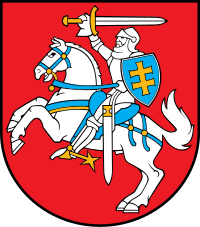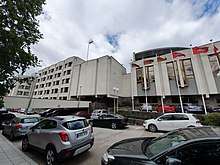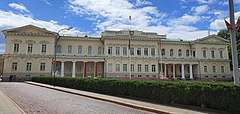Politics of Lithuania
Politics of Lithuania takes place in a framework of a unitary semi-presidential representative democratic republic,[1][2][3][4] whereby the President of Lithuania is the head of state and the Prime Minister of Lithuania is the head of government, and of a multi-party system.
 |
|---|
| This article is part of a series on the politics and government of Lithuania |
|
Legislature |
|
Judiciary |
|
Executive power is exercised by the President and the Government, which is headed by the Prime Minister. Legislative power is vested in both the Government and the unicameral Seimas (Lithuanian Parliament). Judicial power is vested in judges appointed by the President of Lithuania and is independent of executive and legislature power. The judiciary consists of the Constitutional Court, the Supreme Court, and the Court of Appeal as well as the separate administrative courts. The Constitution of the Republic of Lithuania established these powers upon its approval on 25 October 1992. Being a multi-party system, the government of Lithuania is not dominated by any single political party, rather it consists of numerous parties that must work with each other to form coalition governments. The Economist Intelligence Unit rated Lithuania a "flawed democracy" in 2019.[5]
History
Since Lithuania declared independence on 11 March 1990, it has kept strong democratic traditions. Drawing from the interwar experiences, politicians made many different proposals that ranged from strong parliamentarism to a presidential republic with checks and balances similar to the United States. Through compromise, a semi-presidential system was settled.[1] In a referendum on 25 October 1992, the first general vote of the people since their declared independence, 56.75% of the total number of voters supported the new constitution.[6]
All major political parties declared their support for Lithuania's membership in NATO and the European Union (EU). Lithuania joined NATO on 29 March 2004, and joined the EU on 1 May 2004.
Since 1991, Lithuanian voters have shifted from right to left and back again, swinging between the Conservatives, led by Vytautas Landsbergis, and the (formerly Communist) Democratic Labour Party of Lithuania, led by president Algirdas Brazauskas. During this period, the prime minister was Gediminas Vagnorius.
Valdas Adamkus has been the president for most of the time since 1998. His prime minister was Rolandas Paksas, whose government got off to a rocky start and collapsed within seven months. The alternation between left and right was broken in the October 2000 elections when the Liberal Union and New Union parties won the most votes and were able to form a centrist ruling coalition with minor partners. President Adamkus played a key role in bringing the new centrist parties together. Artūras Paulauskas, the leader of the centre-left New Union (also known as the social-liberal party), became the Chairman of the Seimas. In July 2001, the centre-left New Union party forged an alliance with the Social Democratic Party of Lithuania and formed a new cabinet under former president Algirdas Brazauskas. On 11 April 2006, Artūras Paulauskas was removed from his position and Viktoras Muntianas was elected Chairman of the Seimas.[7]
The cabinet of Algirdas Brazauskas resigned on 31 May 2006, as President Valdas Adamkus expressed no confidence in two of the Ministers, formerly party colleagues of Brazauskas, over ethical principles. Brazauskas decided not to remain in office as acting Prime Minister, and announced that he was finally retiring from politics. Even so, he led the ruling Social Democratic Party of Lithuania for one more year, until 19 May 2007, when he passed the reins to Gediminas Kirkilas. On 27 November 2008, Andrius Kubilius was appointed as a Prime Minister. In 2012, Algirdas Butkevičius became the Prime Minister. On 22 November 2016, Saulius Skvernelis became the new and current Prime Minister.
Government
Government in Lithuania is made up of three branches originally envisioned by enlightenment philosopher Baron de Montesquieu: executive, legislative, and judicial. Each branch is separate and is set up to do checks and balances on each other branch.
Executive branch
The executive branch of the Lithuanian government consists of a President, a Prime Minister, and the President's Council of Ministers. It is in charge of running the government.
President
The President of Lithuania is the head of state of the country, elected directly for a five-year term and can serve maximum of two terms consecutively. Presidential elections take place in a modified version of the two-round system. If half of voters participate, a candidate must win a majority of the total valid vote in order to win election in the first round. If fewer than half participate, a candidate can win outright with a plurality, provided that he or she wins at least one third of the total vote. If the first round does not produce a president, a runoff is held between the top two finishers in the first round, with a plurality sufficient to win.
The President, with the approval of the Seimas, is first responsible of appointing the Prime Minister. Upon the Prime Minister's nomination, the President also appoints, under the recommendation of the Prime Minister, the Council of Ministers (13 ministries), as well as a number of other top civil servants and the judges for all courts. The President also serves as the commander-in-chief, oversees foreign and security policy, addresses political problems of foreign and domestic affairs, proclaims states of emergency, considers the laws adopted by the Seimas, and performs other duties specified in the Constitution.[8] Lithuanian presidents have somewhat greater power than their counterparts in Estonia and Latvia, but have more influence in foreign policy than domestic policy.
Dalia Grybauskaitė has served as the president of Lithuania since July 2009, winning a reelection bid in 2014. Grybauskaitė succeeded Valdas Adamkus who had served a total of two non-consecutive terms. Former President Rolandas Paksas, who had defeated Adamkus in 2003, was impeached in April 2004 for leaking classified information.
Prime Minister

The Prime Minister of Lithuania is the head of government of the country, appointed by the President and approved by the Seimas. The Prime Minister, within 15 days of being appointed, is responsible for choosing Ministers for the President to approve to each of the 13 Ministries. In general, the Prime Minister is in charge of the affairs of the country, maintains homeland security, carries out laws and resolutions of the Seimas and decrees of the President, maintains diplomatic relations with foreign countries and international organizations, and performs other duties specified in the Constitution.[8] In practice, the Prime Minister is mostly responsible for domestic policy, while the President mostly handles foreign policy.
Council of Ministers
Similar to the cabinet of other nations, the Council of Ministers consists of 13 Ministers chosen by the Prime Minister and appointed by the President. Each Minister is responsible for his or her own Ministry of the Lithuanian government and must give reports on his or her Ministry when directed to.[9] When the Prime Minister resigns or dies, the position is to be filled as soon as possible and the new leader will appoint a new Government.
Current office holders
| Office | Name | Party | Since |
|---|---|---|---|
| President | Gitanas Nausėda | Independent | 12 July 2019 |
| Prime Minister | Saulius Skvernelis | Independent (endorsed by Lithuanian Farmers and Greens Union) | 13 December 2016 |
Legislative branch
The parliament (Seimas) has 141 members that are elected for a 4-year term. About half of the members are elected in single-member districts (71), and the other half (70) are elected in the nationwide vote using proportional representation by party lists. A party must receive at least 5% of the national vote to be represented in the Seimas.
Political parties and elections
2019 presidential election
| Candidate | Party | First round | Second round | ||
|---|---|---|---|---|---|
| Votes | % | Votes | % | ||
| Ingrida Šimonytė | Independent | 442,353 | 31.43 | 437,399 | 33.28 |
| Gitanas Nausėda | Independent | 438,469 | 31.16 | 876,749 | 66.72 |
| Saulius Skvernelis | Independent | 278,680 | 19.80 | ||
| Vytenis Andriukaitis | Social Democratic Party of Lithuania | 67,802 | 4.82 | ||
| Arvydas Juozaitis | Independent | 66,535 | 4.73 | ||
| Valdemar Tomaševski | Electoral Action of Poles in Lithuania | 56,411 | 4.01 | ||
| Mindaugas Puidokas | Independent | 36,645 | 2.60 | ||
| Naglis Puteikis | Lithuanian Centre Party | 11,214 | 0.80 | ||
| Valentinas Mazuronis | Independent | 9,169 | 0.65 | ||
| Invalid/blank votes | 9,905 | – | 17,097 | – | |
| Total | 1,417,183 | 100 | 1,314,148 | 100 | |
| Registered voters/turnout | 2,486,915 | 56.99 | 2,491,021 | 53.44 | |
| Source: VRK, VRK | |||||
2016 parliamentary election
| Party | Nationwide constituency | Single-member constituencies | Total seats |
+/– | ||||||||
|---|---|---|---|---|---|---|---|---|---|---|---|---|
| First round | Second round | |||||||||||
| Votes | %[10] | Seats | Votes | %[10] | Seats | Votes | %[10] | Seats | ||||
| Homeland Union – Lithuanian Christian Democrats | 276,275 | 22.63 | 20 | 258,834 | 21.57 | 1 | 246,108 | 27.94 | 10 | 31 | –2 | |
| Lithuanian Farmers and Greens Union | 274,108 | 22.45 | 19 | 229,769 | 19.15 | 0 | 311,611 | 35.38 | 35 | 54 | +53 | |
| Social Democratic Party of Lithuania | 183,597 | 15.04 | 13 | 183,267 | 15.27 | 0 | 115,599 | 13.12 | 4 | 17 | –21 | |
| Liberal Movement | 115,361 | 9.45 | 8 | 139,522 | 11.63 | 0 | 70,055 | 7.95 | 6 | 14 | +4 | |
| Anti-Corruption Coalition (LCP–LPP) | 77,114 | 6.32 | 0 | 36,621 | 3.05 | 0 | 6,876 | 0.78 | 1 | 1 | New | |
| Electoral Action of Poles in Lithuania – Christian Families Alliance | 69,810 | 5.72 | 5 | 63,291 | 5.27 | 2 | 13,526 | 1.54 | 1 | 8 | 0 | |
| Order and Justice | 67,817 | 5.55 | 5 | 70,958 | 5.91 | 0 | 28,894 | 3.28 | 3 | 8 | –3 | |
| Labour Party | 59,620 | 4.88 | 0 | 79,824 | 6.65 | 0 | 25,803 | 2.93 | 2 | 2 | –27 | |
| Lithuanian Freedom Union (Liberals) | 27,274 | 2.23 | 0 | 39,987 | 3.33 | 0 | 10,130 | 1.15 | 0 | 0 | New | |
| Lithuanian Green Party | 24,727 | 2.03 | 0 | 11,047 | 0.92 | 0 | 5,627 | 0.64 | 1 | 1 | New | |
| Lithuanian List | 21,966 | 1.80 | 0 | 17,519 | 1.46 | 0 | 8,709 | 0.99 | 1 | 1 | New | |
| Lithuanian People's Party | 12,851 | 1.05 | 0 | 9,767 | 0.81 | 0 | – | – | – | 0 | 0 | |
| Against Corruption and Poverty (JL–LTS) | 6,867 | 0.56 | 0 | 4,150 | 0.35 | 0 | – | – | – | 0 | New | |
| The Way of Courage | 3,498 | 0.29 | 0 | 4,619 | 0.38 | 0 | – | – | – | 0 | –7 | |
| Independents | – | – | – | 50,738 | 4.23 | 0 | 37,919 | 4.30 | 4 | 4 | +1 | |
| Invalid/blank votes | 52,469 | – | – | 72,789 | – | – | 32,895 | – | – | – | – | |
| Total | 1,273,427 | 100 | 70 | 1,272,734 | 100 | 3 | 913,752 | 100 | 68 | 141 | 0 | |
| Registered voters/turnout | 2,514,657 | 50.64 | – | 2,514,657 | 50.61 | – | 2,405,143 | 37.99 | – | – | – | |
| Source: Central Electoral Commission[11] | ||||||||||||
2019 European election
| Party | Votes | % | Seats | |
|---|---|---|---|---|
| Homeland Union | 245,918 | 18.60 | 3 | |
| Social Democratic Party of Lithuania | 199,217 | 17.26 | 2 | |
| Lithuanian Farmers and Greens Union | 157,604 | 11.92 | 2 | |
| Labour Party | 112,964 | 8.54 | 1 | |
| Liberal Movement | 81,916 | 6.20 | 1 | |
| Public election committee "Aušra Maldeikienė's Train" | 80,703 | 6.10 | 1 | |
| "Waldemar Tomaszewski Block" - Coalition of Christian Families Alliance and Lithuanian Russian Union | 69,263 | 5.24 | 1 | |
| Lithuanian Centre Party | 64,091 | 4.85 | 0 | |
| Public election committee "President Rolandas Paksas' Movement" | 50,130 | 3.79 | 0 | |
| Public election committee "Vytautas Radžvilas: Recover the State!" | 41,860 | 3.17 | 0 | |
| Order and Justice | 34,298 | 2.59 | 0 | |
| Social Democratic Labour Party of Lithuania | 29,592 | 2.24 | 0 | |
| Lithuanian Green Party | 28,126 | 2.13 | 0 | |
| Lithuanian Freedom Union (Liberals) | 23,829 | 1.80 | 0 | |
| Public election committee "Strong Lithuania in United Europe" | 16,671 | 1.26 | 0 | |
| Public election committee "Decisive Leap" | 16,671 | 1.07 | 0 | |
| Total | 1,250,377 | 100.00 | 11 | |
Judicial branch
The judges of the Constitutional Court of the Republic of Lithuania (Lietuvos Respublikos Konstitucinis Teismas) for a single nine-year term are appointed by the Seimas from the candidates presented by the President (three judges), Chairman of Seimas (three judges) and the chairman of the Supreme Court (three judges).
Administrative divisions
Lithuania has a three-tier administrative division: the country is divided into 10 counties (Lithuanian: singular – apskritis, plural – apskritys) that are further subdivided into 60 municipalities (Lithuanian: singular – savivaldybė, plural – savivaldybės) which consist of over 500 elderships (Lithuanian: singular – seniūnija, plural – seniūnijos).
The county governors (Lithuanian: apskrities viršininkas) institution and county administrations have been dissolved in 2010.[12]
Municipalities are the most important administrative unit. Some municipalities are historically called "district municipalities", and thus are often shortened to "district"; others are called "city municipalities", sometimes shortened to "city". Each municipality has its own elected government. In the past, the election of municipality councils occurred once every three years, but it now takes place every four years. The council appoints elders to govern the elderships. Mayors are elected directly since 2015, being appointed by the council before that.[13]
International organization participation
References
- Kulikauskienė, Lina (2002). Lietuvos Respublikos Konstitucija [The Constitution of the Republic of Lithuania] (in Lithuanian). Native History, CD. ISBN 9986-9216-7-8.
- Veser, Ernst (23 September 1997). "Semi-Presidentialism-Duverger's Concept – A New Political System Model" (PDF) (in English and Chinese). Department of Education, School of Education, University of Cologne: 39–60. Retrieved 23 August 2017.
Duhamel has developed the approach further: He stresses that the French construction does not correspond to either parliamentary or the presidential form of government, and then develops the distinction of 'système politique' and 'régime constitutionnel'. While the former comprises the exercise of power that results from the dominant institutional practice, the latter is the totality of the rules for the dominant institutional practice of the power. In this way, France appears as 'presidentialist system' endowed with a 'semi-presidential regime' (1983: 587). By this standard he recognizes Duverger's pléiade as semi-presidential regimes, as well as Poland, Romania, Bulgaria and Lithuania (1993: 87).
Cite journal requires|journal=(help) - Shugart, Matthew Søberg (September 2005). "Semi-Presidential Systems: Dual Executive and Mixed Authority Patterns" (PDF). Graduate School of International Relations and Pacific Studies. United States: University of California, San Diego. Archived from the original (PDF) on 19 August 2008. Retrieved 23 August 2017.CS1 maint: ref=harv (link)
- Shugart, Matthew Søberg (December 2005). "Semi-Presidential Systems: Dual Executive And Mixed Authority Patterns" (PDF). French Politics. Palgrave Macmillan Journals. 3 (3): 323–351. doi:10.1057/palgrave.fp.8200087. Retrieved 23 August 2017.
A pattern similar to the French case of compatible majorities alternating with periods of cohabitation emerged in Lithuania, where Talat-Kelpsa (2001) notes that the ability of the Lithuanian president to influence government formation and policy declined abruptly when he lost the sympathetic majority in parliament.
CS1 maint: ref=harv (link) - The Economist Intelligence Unit (8 January 2019). "Democracy Index 2019". Economist Intelligence Unit. Retrieved 13 January 2019.
- Nuo 1991 m. iki šiol paskelbtų referendumų rezultatai (Results from Refrenda 1991 – present), Microsoft Word Document, Seimas. Accessed 4 June 2006.
- "Government of Lithuania". Vil S. Vaitas, P.E. and Associates International Consultants. Fairfax, VA.
- Lithuanian Home Page Archived 1 September 2006 at the Wayback Machine
- Lithuania in the European Union - Coordination of European Union Affairs in Lithuania
- Percentage share of valid votes; Lithuanian Central Electoral Committee present figures including both valid and invalid votes.
- "2016 m. Seimo rinkimų rezultatai" [Results of the 2016 Seimas elections] (in Lithuanian). Central Electoral Commission. 24 October 2016. Archived from the original on 14 April 2018. Retrieved 25 October 2016.
- (in Lithuanian) (Republic of Lithuania Annul Law on County Governing), Seimas law database, 7 July 2009, Law no. XI-318.
- (in Lithuanian) Justinas Vanagas, Seimo Seimas įteisino tiesioginius merų rinkimus Archived 14 October 2017 at the Wayback Machine, Delfi.lt, 26 June 2014. Retrieved 26 March 2015.

